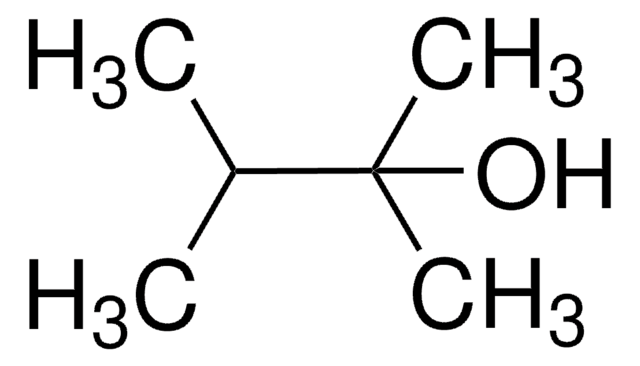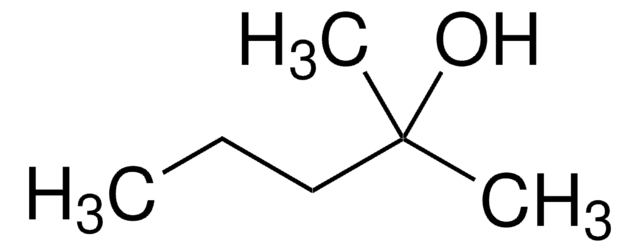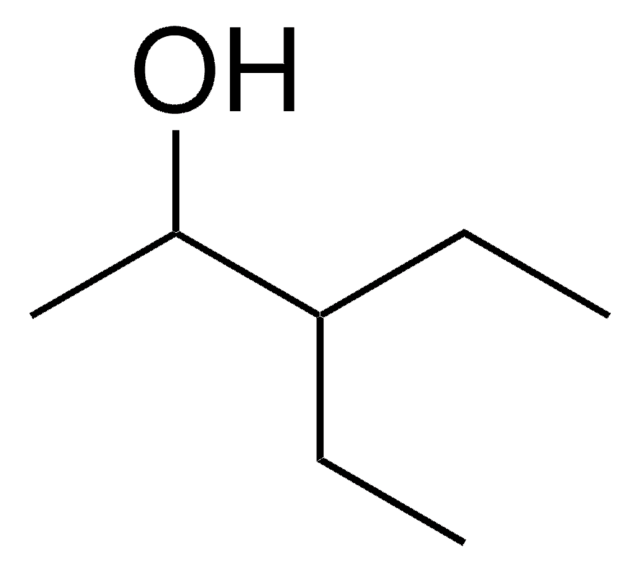111570
3-Ethyl-3-pentanol
98%
Sinonimo/i:
Triethylcarbinol
Autenticatiper visualizzare i prezzi riservati alla tua organizzazione & contrattuali
About This Item
Formula condensata:
(C2H5)3COH
Numero CAS:
Peso molecolare:
116.20
Beilstein:
1731643
Numero CE:
Numero MDL:
Codice UNSPSC:
12352100
ID PubChem:
NACRES:
NA.22
Prodotti consigliati
Livello qualitativo
Saggio
98%
Indice di rifrazione
n20/D 1.430 (lit.)
P. eboll.
141 °C/743 mmHg (lit.)
Densità
0.824 g/mL at 25 °C (lit.)
Gruppo funzionale
hydroxyl
Stringa SMILE
CCC(O)(CC)CC
InChI
1S/C7H16O/c1-4-7(8,5-2)6-3/h8H,4-6H2,1-3H3
XKIRHOWVQWCYBT-UHFFFAOYSA-N
Cerchi prodotti simili? Visita Guida al confronto tra prodotti
Applicazioni
3-Ethyl-3-pentanol was used to study the effect of alkanols on the micropolarity and microviscosity of the head group region, in the reverse micelles of AOT-heptane-water by fluorescence probing. 3-Ethyl-3-pentanols were encapsulated in the hexamers of resorcin[4]arenes.
Avvertenze
Warning
Indicazioni di pericolo
Consigli di prudenza
Classi di pericolo
Flam. Liq. 3
Codice della classe di stoccaggio
3 - Flammable liquids
Classe di pericolosità dell'acqua (WGK)
WGK 3
Punto d’infiammabilità (°F)
100.4 °F - closed cup
Punto d’infiammabilità (°C)
38 °C - closed cup
Dispositivi di protezione individuale
Eyeshields, Faceshields, Gloves, type ABEK (EN14387) respirator filter
Scegli una delle versioni più recenti:
Possiedi già questo prodotto?
I documenti relativi ai prodotti acquistati recentemente sono disponibili nell’Archivio dei documenti.
Raymond Behrendt et al.
Journal of peptide science : an official publication of the European Peptide Society, 21(8), 680-687 (2015-06-17)
Obtaining homogenous aspartyl-containing peptides via Fmoc/tBu chemistry is often an insurmountable obstacle. A generic solution for this issue utilising an optimised side-chain protection strategy that minimises aspartimide formation would therefore be most desirable. To this end, we developed the following
Elsa Abuin et al.
Journal of colloid and interface science, 258(2), 363-366 (2003-03-06)
The effects of addition of alkanols (ethanol, n-hexanol, and 3-ethyl-3-pentanol) on the micropolarity and microviscosity of the head group region in reverse micelles of AOT-heptane-water have been investigated by fluorescence probing methods (ANS fluorescence yield and TMADPH fluorescence anisotropy), complemented
Sarit Slovak et al.
Chemistry (Weinheim an der Bergstrasse, Germany), 18(27), 8515-8520 (2012-05-29)
After more than a century of research on resorcin[4]arenes (1) it is clear that such systems form spontaneously [1(6)(H(2)O)(8)]-type hexameric capsules in wet, non-polar, organic solvents. However, the interactions of these hexameric capsules with alcohols are far from being solved.
Il team dei nostri ricercatori vanta grande esperienza in tutte le aree della ricerca quali Life Science, scienza dei materiali, sintesi chimica, cromatografia, discipline analitiche, ecc..
Contatta l'Assistenza Tecnica.









